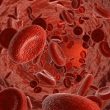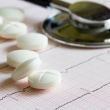This is a sub-study of the THEMIS presented during the ESC 2019 scientific sessions in Paris, and simultaneously published in Lancet. They were all diabetics with stable coronary artery disease, but in this sub-study patients also had prior PCI. It included over 11000 patients with prior PCI for whom the combination of ticagrelor and aspirin<a href="https://solaci.org/en/2019/09/03/esc-2019-themis-pci-unlike-in-the-main-study-here-ticagrelor-is-indeed-effective/" title="Read more" >...</a>
ESC 2019 | POPULAR AGE: Good Old Clopidogrel Still Valid
According to this study, presented during the ESC 2019 scientific sessions, non-ST acute coronary syndrome (NSTE-ACS) patients treated with ticagrelor presented a significantly higher risk of bleeding than patients treated with clopidogrel, with no counterbalance by higher benefit in thrombotic events. Researchers suggest clopidogrel might be the gold standard for this elderly NSTE-ACS population, though<a href="https://solaci.org/en/2019/09/03/esc-2019-popular-age-good-old-clopidogrel-still-valid/" title="Read more" >...</a>
PCI and Anticoagulation: What is the best strategy?
Most patients with atrial fibrillation require anticoagulation to reduce the risk of stroke or systemic embolization. Today, this is achieved with the new direct oral anticoagulants, which present lower intracranial bleeding risk compared against the old vitamin K antagonists. On the other hand, approximately between 5% to 10% of patients receiving PCI also present atrial<a href="https://solaci.org/en/2019/08/14/pci-and-anticoagulation-what-is-the-best-strategy/" title="Read more" >...</a>
The “Ten Commandments” of Myocardial Revascularization According to Europe
The new European guidelines on myocardial revascularization were developed by a joint effort of the European Society of Cardiology (ESC) and the European Association of Cardiovascular Surgery (EACTS). These guidelines are intended to support clinical practice with pragmatic recommendations based on currently available evidence and on personal experience, whenever evidence is missing. Both coronary angioplasty<a href="https://solaci.org/en/2019/01/24/the-ten-commandments-of-myocardial-revascularization-according-to-europe/" title="Read more" >...</a>
E-Cigarettes: No Definitive Evidence on Their Potential Cardiovascular Effect, but Some Suggest Caution
E-cigarettes may bring about cardiac risk according to a new literature review soon to be published in J Am Coll Cardiol. The evidence on potential harm is not definitive, but some experts suggest caution in their use until there is more solid evidence. E-cigarettes have been advertised as a healthy alternative to traditional cigarettes and<a href="https://solaci.org/en/2018/12/18/e-cigarettes-no-definitive-evidence-on-their-potential-cardiovascular-effect-but-some-suggest-caution/" title="Read more" >...</a>
Clinical Utility of CT-Derived FFR for Decision-Making
In this large international multicenter population, computed-tomography (CT)-derived fractional flow reserve (FFR) modified treatment recommendation in two-thirds of subjects compared with CT angiography alone, and it was associated with less negative invasive angiographies. It also predicted revascularization and identified low-risk patients. A non-invasive means to know the anatomy and function of patients with stable chronic<a href="https://solaci.org/en/2018/11/21/clinical-utility-of-ct-derived-ffr-for-decision-making/" title="Read more" >...</a>
Cautious Administration of Supplemental 02, Especially in Acute Stroke or MI
Recent studies show the potential damaging effect of supplemental oxygen in the context of acute stroke and myocardial infarction. Experts now say that it should not be used in patients with >92% oxygen saturation. These guidelines have looked into the most recent studies, including the DET02X-AMI, which suggest supplemental oxygen therapy could increase mortality in<a href="https://solaci.org/en/2018/11/21/cautious-administration-of-supplemental-02-especially-in-acute-stroke-or-mi/" title="Read more" >...</a>
TCT 2018 | SORT OUT IX: Polymer-Free DES with Ultra-Thin Struts vs. Bioresorbable Polymer- Based DES
Polymer persistence in 1st and 2nd generation DES meant to allow drug release has been associated with a chronic inflammatory response that might be associated to restenosis, neo atherosclerosis and stent thrombosis. This is the rationale behind the development of polymer free and bioresorbable polymer-based DES. They have both been compared against permanent polymer DES,<a href="https://solaci.org/en/2018/10/03/tct-2018-sort-out-ix-polymer-free-des-with-ultra-thin-struts-vs-bioresorbable-polymer-based-des/" title="Read more" >...</a>
Ten Commandments of the European Hypertension Guidelines: Several “Sins Allowed” Compared with American Guidelines
These new hypertension guidelines (which were as long-awaited as the American ones, back then) finally emerged in Barcelona, at the European Society of Hypertension (ESH) Congress. The document was issued jointly with the European Society of Cardiology (ESC). These guidelines provide recommendations for physicians to diagnose hypertension, evaluate risk, and determine when and how to<a href="https://solaci.org/en/2018/09/25/ten-commandments-of-the-european-hypertension-guidelines-several-sins-allowed-compared-with-american-guidelines/" title="Read more" >...</a>
Can We Prevent Cardiovascular Events without Aspirin?
As regards the use of antithrombotic agents, the risk of bleeding will always be an issue, and in the case of aspirin this risk is twice as big: it does have the desired antiaggregation effect, but on top of the increased bleeding risk, it has a damaging effect on stomach lining that increases the risk<a href="https://solaci.org/en/2018/07/25/can-we-prevent-cardiovascular-events-without-aspirin/" title="Read more" >...</a>









